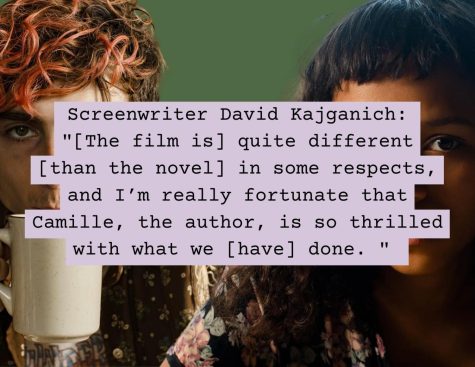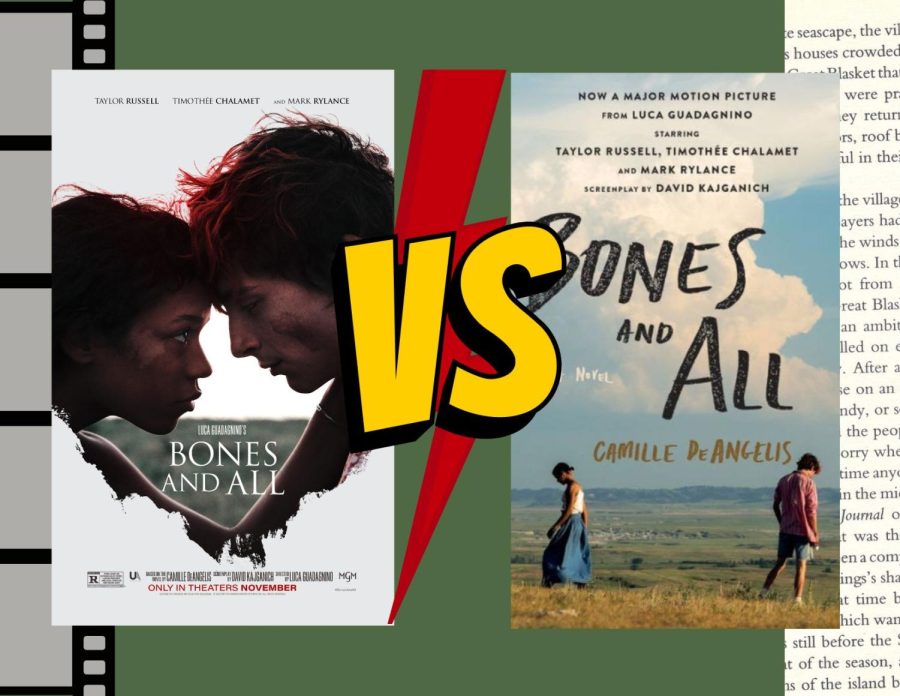Book review: “Bones and All”
The film “Bones and All” was released in 2022 and has been nominated for numerous awards at indie film festivals around the world. Graphic by: Avery Cameron
February 17, 2023
Is the book always better? Yes
Luca Guadagnino’s 2022 film “Bones and All,” starring Taylor Russell and Timothée Chalamet, is a coming-of-age story that follows Russell’s character, Maren Yearly, in the 1980s as an 18-year-old cannibal on a road trip through the Midwest to find her mother who abandoned her. Along the way, she meets other “eaters” like her, including Mark Rylance’s Sully, and her romantic interest in the film, Chalamet’s Lee. Guadagnino’s film was based on Camille DeAngelis’ 2017 novel of the same name and adapted to a film by screenwriter David Kajganich. Before I watched the film I read the novel, which I enjoyed more than the film. It’s a very faced paced young adult genre that I’d recommend to everyone interested, regardless if they’ve seen the film first.
Kajganich made lots of changes when writing the script, including gender swapping characters, switching characters’ ages, and spotlighting the romance, whereas, in DeAngelis’ novel, it was a mere subplot.
Cece Perez ‘23 has not read the novel but rated the film four out of five. Perez said, “I thought [the film] was so good [and] at some points it got kinda boring but it picked back up. It was so appealing to watch.”
I think I enjoyed the novel more because of the narration from Yearly. It was much more relatable and interesting reading from 16-year-old Yearly’s point of view, whereas in the film, she was 18 because she was a much more developed and multi-dimensional character. In the film, filmmakers seemed to focus more on cannibalism and romance plots instead of the characters. Overall it was much easier to relate and sympathize with a cannibal by reading than watching.
One of the main differences that stuck out to me in the film was that rather than Maren not having a relationship with her father, like in the novel, it is instead her mother whom she is searching for.
In an interview with The Credits, Kajganich said, “I thought that the betrayal that Maren might feel of knowing that there was a parent who could have spoken directly to her experience, not across the line of gender, but within her own gender, that seemed more crushing to me, that seemed more emotional to me.”
DeAngelis’ novel also has an element of magical realism, where cannibalism, the cause, and the effects aren’t really explained. For example, in the opening chapter of the novel, a sixth-month-old kills her adult babysitter without much of an explanation, which was confusing, but I liked how DeAngelis wrote it that way, without much of an explanation, you just go along with it.
Kajganich said, “There is a kind of fairy tale tone to the book that allows the eaters, for instance, to eat the people they eat entirely and quickly, so it’s almost a kind of magical thing that happens in the book. That tone obviously isn’t something that was gonna work on screen.”
The romance was also different in the novel, with Maren merely having a crush-like infatuation with Lee when in the film, they were in a much more developed romantic relationship with one another.

Perez said, “I think my favorite part was the ending when they are together in the house before they end up killing [Sully]. I think it really captured what they wanted and showed their ‘normal’ life.”
Jasmine Bruns ‘23 has not read the book but enjoyed the movie. She said, “I would rate the film a four out of five because at some points the gory parts were hard to watch but the conceptual elements and taboo of cannibalism combined with love was interesting.”
Following that scene, the film comes to the end when Sully returns to take revenge and attempt to kill Maren and Lee. Maren and Lee instead kill Sully, but Lee goes down with him, asking Maren to consume him “bones and all.”
The ending differed in the novel, which I preferred, where Maren lives quietly on her own in a midwestern college town as a bookkeeper after peacefully parting ways with Lee. Ending with her killing a man who made sexual advances on her, leaving her fate in the reader’s perception.
Overall, the book is always better in my opinion, and I’ll always recommend reading it before watching any film or show. Guadaginios film was great, with amazing cinematography and performances. However, I could only feel disappointed when I finished, wondering what could’ve been if filmmakers stuck to the novel’s plot.









![Lindsay Guzik, new assistant principal said, "I am settling in [at VHS] pretty well. I know a lot of the students, so that makes it a little bit easier coming from Cabrillo, and it's been nice to see them all grown up." Photo by: Abraham Kassa](https://thecougarpress.org/wp-content/uploads/2025/09/IMG_9728-300x200.jpg)